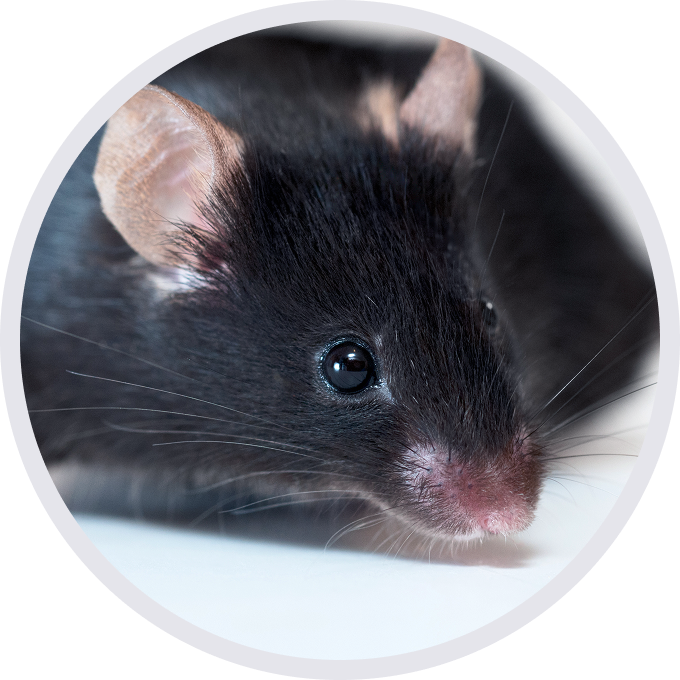
C57BL/6-Hgftm2(HGF)Bcgen Mettm1(MET)Bcgen Fcgrttm1(FCGRT)Bcgen/Bcgen • 114054

| Product name | B-hHGF/hMET/hFcRn mice |
|---|---|
| Catalog number | 114054 |
| Strain name | C57BL/6-Hgftm2(HGF)Bcgen Mettm1(MET)Bcgen Fcgrttm1(FCGRT)Bcgen/Bcgen |
| Strain background | C57BL/6 |
| NCBI gene ID | 3082,4233,2217 (Human) |
| Aliases | SF; HGFB; HPTA; F-TCF; DFNB39; DA11; HGFR; AUTS9; RCCP2; c-Met; DFNB97; FCRN; FcgammaRn; alpha-chain |
Gene targeting strategy for B-hHGF/hMET/hFcRn mice.
The CDS that encodes the full-length human HGF protein, followed by mouse 3’UTR-STOP and polyA signal sequence was inserted into exon 3 of mouse Hgf to replace part of exon 3 to exon 6 of mouse Hgf gene. The promoter, 5’UTR and signal peptide region of the mouse Hgf gene were also retained. The human HGF protein expression will be driven by endogenous mouse Hgf promoter, while mouse Hgf gene transcription and translation will be disrupted.
The exons 3-14 of mouse Met gene that encode extracellular domain were replaced by human counterparts in B-hHGF/hMET/hFcRn mice. The genomic region of mouse Met gene that encodes transmembrane domain and cytoplasmic portion was retained. The promoter, 5’UTR and 3’UTR region, and signal peptide of the mouse gene were also retained. The chimeric MET expression was driven by endogenous mouse Met promoter, while mouse Met gene transcription and translation will be disrupted.
The human full-length FCGRT cDNA sequence was inserted into exon 2 of the mouse Fcgrt gene.

Strain specific HGF expression analysis in wild-type C57BL/6JNifdc mice and B-hHGF/hMET/hFcRn mice by ELISA. Serum was collected from wild-type C57BL/6JNifdc mice (+/+) (female, n=3, 9-week-old) and homozygous B-hHGF/hMET/hFcRn mice (H/H) (female, n=3, 10-week-old). Expression level of mouse and human HGF were analyzed by ELISA (anti-mouse HGF ELISA kit: R&D, MHG00; anti-human HGF ELISA kit: abcam, ab275901). Mouse HGF was only detectable in wild-type C57BL/6JNifdc mice. Human HGF was exclusively detectable in homozygous B-hHGF/hMET/hFcRn mice. Values are expressed as mean ± SEM.
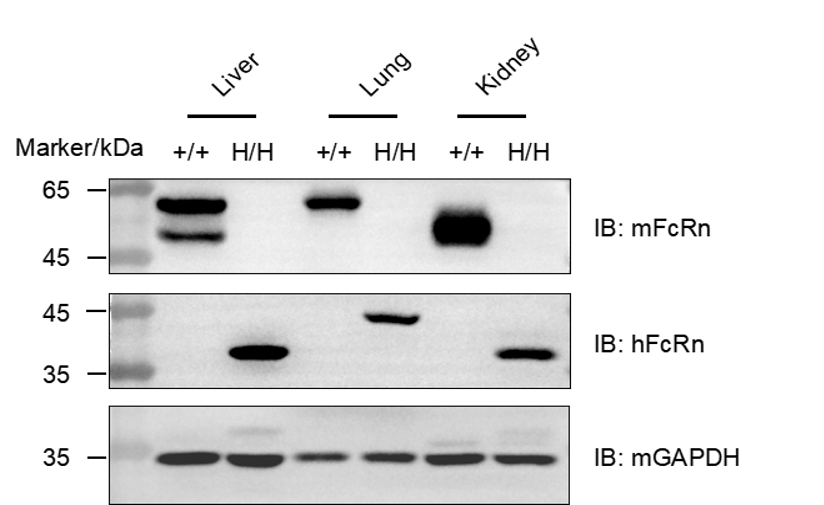
Western blot analysis of FcRn protein expression in homozygous B-hHGF/hMET/hFcRn mice. Various tissue lysates were collected from wild-type C57BL/6JNifdc mice (+/+) and homozygous B-hHGF/hMET/hFcRn mice (H/H), and then analyzed by western blot with species-specific anti-FcRn antibody(anti-mouse FcRn antibody: R&D, AF6775; anti-human FcRn antibody: Novus Biologicals, NBP1-89128). 40 μg total proteins were loaded for western blotting analysis. Mouse FcRn was only detectable in wild-type C57BL/6JNifdc mice, but not in homozygous B-hHGF/hMET/hFcRn mice. Human FcRn was exclusively detectable in homozygous B-hHGF/hMET/hFcRn mice.
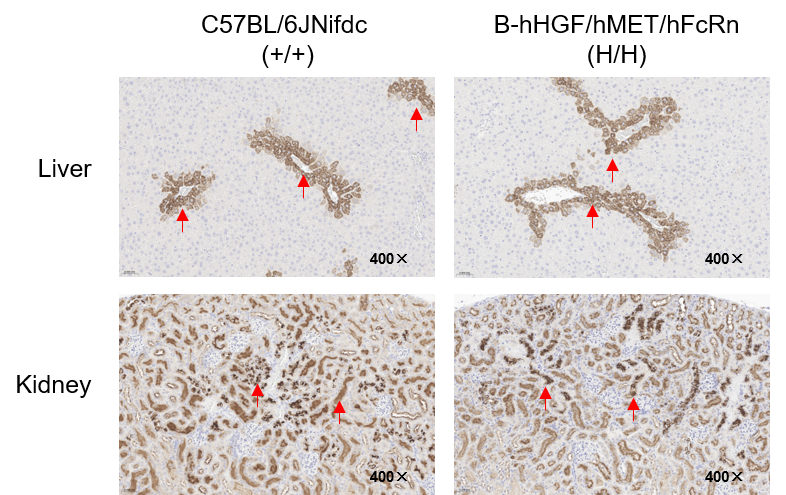
Immunohistochemical (IHC) analysis of MET expression in wild-type C57BL/6JNifdc mice and homozygous B-hHGF/hMET/hFcRn mice. The liver and kidney were collected from wild-type C57BL/6JNifdc mice (+/+) and B-hHGF/hMET/hFcRn mice (H/H) and analyzed by IHC with anti-MET antibody(abcam, ab227637). MET was detectable in wild-type mice and homozygous B-hEGFR/hMET/hHGF mice due to the cross-reactivity of antibodies.
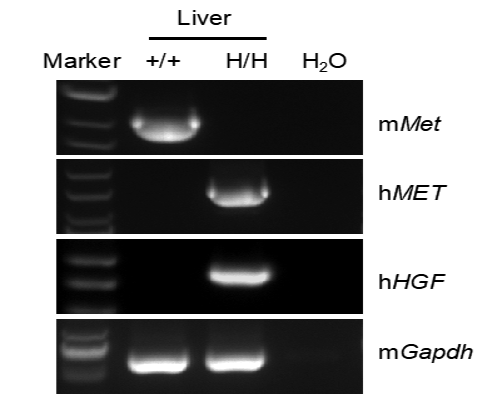
Strain specific analysis of HGF and MET mRNA expression in wild-type C57BL/6JNifdc mice and B-hHGF/hMET/hFcRn mice by RT-PCR. Liver RNA were isolated from wild-type C57BL/6JNifdc (+/+) and homozygous B-hHGF/hMET/hFcRn mice (H/H), then cDNA libraries were synthesized by reverse transcriptio, followed by PCR with mouse or human HGF and MET primers. Mouse Met mRNA was detectable only in wild-type C57BL/6JNifdc mice. Human HGF and MET mRNA was detectable only in homozygous B-hHGF/hMET/hFcRn mice but not in wild-type mice.
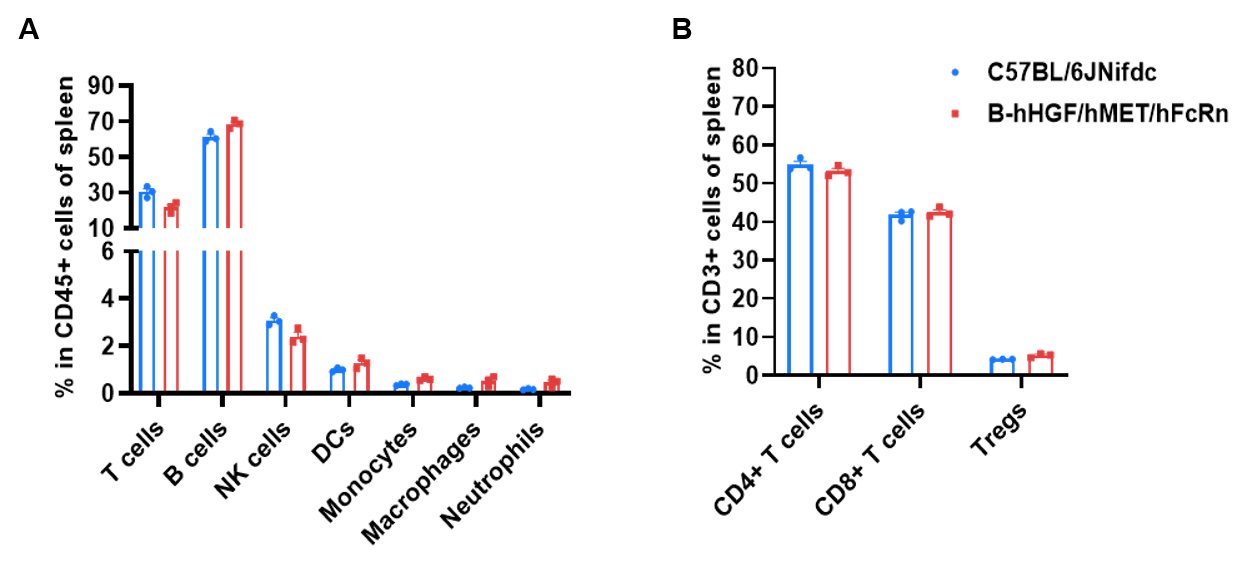
Frequency of leukocyte subpopulations in spleen by flow cytometry. Splenocytes were isolated from wild-type C57BL/6JNifdc mice (female, 9-week-old, n=3) and homozygous B-hHGF/hMET/hFcRn mice (female,10-week-old, n=3). A. Flow cytometry analysis of the splenocytes was performed to assess the frequency of leukocyte subpopulations. B. Frequency of T cell subpopulations. Frequencies of T cells, B cells, NK cells, DCs, monocytes, macrophages, neutrophils, CD4+ T cells, CD8+ T cells and Tregs in B-hHGF/hMET/hFcRn mice were similar to those in C57BL/6JNifdc mice, demonstrating that humanization of HGF, MET and FcRn does not change the frequency or distribution of these cell types in spleen. The frequency of leukocyte subpopulations in blood and lymph node of B-hHGF/hMET/hFcRn mice were also comparable to wild-type C57BL/6JNifdc mice (Data not shown). Values are expressed as mean ± SEM.